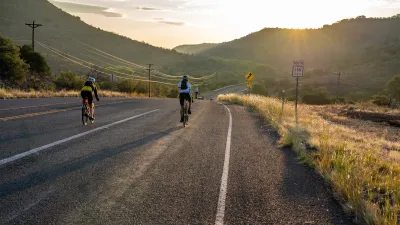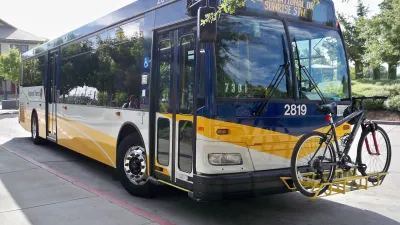Rachel Smith of AECOM says that seven-meter wide cycling "super highways" are the X-factor to transform our cities, our lifestyles and our health and revolutionize the way we travel.
The western world is in the midst of an obesity crisis, coupled with heart disease and diabetes spiraling out of control. Personal, mortgage and government debts are at levels never seen before and day after day we all crawl about our daily lives stuck in time consuming and costly traffic congestion. Despite the ever closer threat of peak oil and energy vulnerability, our infrastructure leaders continue to plan and build more roads, more motorways and more tunnels in a pitiful attempt to build our way out of congestion. Ironically though there is not one single city in the world saying 'We want more cars driving around our city'. Our sedentary, stressful and economically unviable lifestyles and pathetic city building persuasions are slowly, but quietly, killing us.
In order to change this, I've developed a concept for city building and personal travel which could transform our cities, our lifestyles and our health.
My vision is a network of Cycling Super Highways:
- 7.7 metre wide dedicated and separated cycle paths
- Completely separated from parked and moving vehicles
- Safe enough for everyone to use regardless of age, physical abilities or cycling skills

In 2007 I was part of the ConnectWest consortium (Comprising of AECOM, SKM and Philips Group). We were commissioned by the Queensland Government to develop a fully integrated multi-modal transport strategy for Western Brisbane. Whilst working on the WBTNI (Western Brisbane Transport Network Investigation), Enrique Penalosa, the former Mayor of Bogota visited Brisbane. It was Enrique's quote "A protected bicycle path is a symbol that a citizen on a $30 bicycle is as equally important as one in a $30,000 car" that inspired our ConnectWest team to develop a network of 11 metre wide 'Veloways" (high capacity cycle corridors).
I held conversations and focus groups with women, children and seniors in Brisbane (demographic groups who typically don't cycle) to find out why 'normal people' don't cycle. There were no great surprises in my findings: lack of safe and dedicated cycle infrastructure, traffic and personal safety fears, time pressures, personal physical ability, topography, humidity and rainfall all came to bear on people's decisions. The people who I spoke to said above all they wanted complete separation from parked and moving cars.
So I embarked on one Australian and two International study tours to understand the problem, and the possibilities. I visited 21 'Cycling Cities' around the world to discover first-hand what width and types of cycle infrastructure would change a standard city into a 'cycling city'. I found that the common features in these cities were that there was typically 4.0 – 5.0 metres of usable cycle space, and that bi-directional cycleways were separated from motorized traffic.
The X Factor
Whilst in Los Angeles, I read a quote from Gary Fischer on the L.A. Dept. of Transportation's websitewhich said "For the city bike to catch on we need a revolution in our society's infrastructure.".
When Simon Cowell created the X Factor [A U.K. show similar to American Idol] he was looking for superstars; people who would sell millions, even billions, of records around the globe and who would be commercial phenomena. Simon wasn't looking for people to stand in a darkened corner of a local pub and sing on a Tuesday night, he was looking for a revolution.
Cycling Super Highways (CSH) are the X Factor of sustainable transport because 'average, normal, everyday people' will choose to ride bikes, not because they are cyclists but because CSH are:
- Safe
- Comfortable
- Attractive
- Direct
- Connected
Cycle planners and engineers around the world repeatedly build skinny unprotected on–road cycle lanes, often less than 1.0 metre wide and then wonder why 'normal' people – women, children, seniors, commuters, families, tourists - don't cycle. In an attempt to get more people cycling more of the time, those same planners and engineers build more skinny unprotected on-road cycle lanes and not surprisingly people still don't cycle and so the vicious cycle continues.
Current cyclists and people who would consider riding want complete separation from parked and moving cars. Cycling Super Highways are the X Factor because they are the infrastructure that will get people out of their cars and cycling for their journey for work, for trips to the shops, for leisure trips, for family excursions, to keep fit and above all cycling because it really good fun.

Cycling Super Highways are:
- Wide enough to cater for everyone – CSH allow two cyclists to cycle side by side because it's a really sociable mode of travel. CSH have enough space for a faster moving cyclist to overtake a slower moving cyclist. Existing on and off road cycle paths are just too narrow for cyclists to cycle side by side and also too narrow for people to overtake one another. You don't want to have to go out cycling as a family and then cycle along in a long crocodile line because the path is 1 metre wide – where's the fun in that?
- Safe enough for everyone to use – CSH are safe enough for everyone to use regardless of their age, physical ability and cycling skills. CSH are safe enough for young children with stabilisers cycling to school to use, mothers on cargo bikes to cycle with their weekly shopping, for cycle couriers delivering parcels, , postmen and doctors doing their daily rounds and seniors cycling for fun to stay fit and healthy plus space enough for the pelotons of lycra wearing sports cyclists in training!
- Protected enough to encourage everyone to cycle - Most people are too scared to cycle close to traffic or parked cars. We currently use on-road cycle lanes - and the brave and courageous cyclists who use them - to ‘protect' our parked cars from moving traffic! CSH are different because cyclists young and old are completely separated from parked and moving cars, SUVs, buses, trucks and petrol tankers.
- Socially inclusive enough to support mobility aids – CSH are wide enough to allow mobility aids and powered wheelchairs to co-exist with bicycles helping to combat issues associated with an ageing population and our obesity crisis.
Above all, Cycling Super Highways are about capacity, about getting more people cycling more of the time, and everyone feeling empowered enough to consider cycling an equal mode of travel. CSH are not about speed and elite sports cyclists
I know we can't just go out tomorrow digging up roads and knocking down houses to build Cycling Super Highways. Likewise, we can't go on living in low-density suburbia dependent on the car for all of our journeys. We really have to think seriously about how we plan, build and sustain our towns and cities into the future. Utility, food and fuel costs are rising rapidly, families are struggling to pay their mortgages and the time, money and stress incurred traveling to and from work gets bigger every year. Cycling isn't going to solve these issues overnight but its free, healthy and whole lot less stressful!
Cycling Super Highway can help to address the issues surrounding rising population and supporting urban land intensification. The cycle highways would be surrounded by higher density mixed use commercial and residential Transit and Bicycle Oriented Developments with adaptable, affordable and climate responsive low-car or car-free housing, to make our towns and cities liveable, sustainable and great places to live, work and play.
Changing the way we view cycling
CSH are also about changing our view of cycling. Cycling, in Australia in particular, is not 'normal' because of our obsessions our obsession with lycra, our obsession with expensive 'all singing all dancing' carbon fibre racing bikes and our obsessions with cycling long distances at super fast speeds
If we really are going to get more people cycling more of the time we need to make it normal and maximize the enjoyment of cycling. Those of us who do cycle need to keep the lycra for the privacy of our own homes. We need to stop lecturing people about the health benefits. We're fat, we know we don't need reminding! We need to stop bullying people who ride comfortable dutch bikes or who have bikes with baskets. Baskets aren't for girls, they are cycle chic especially in Amsterdam!
We need to leave the 'safety gear' for sky diving cycling isn't dangerous, we have just created a sense of fear and we need to leave the high-vis jackets for high-vis activities like working at a supermarket. We, the people who already cycle, need to put our efforts into getting out there cycling with normal bikes, in our normal everyday clothes and having normal 'fun' because bikes help to make great streets and if we all work together we can use those great streets to create great cities to live, work and play in.
Rachel Smith has spent the last 12 years working in cycle planning and travel behaviour change in the private, public and community sectors in the UK and Australia. Rachel won the 2003 BP Road Safety Award for creating the '100 club' and quadrupling the number of children walking to school, has developed bicycle projects for international tourism destinations including the Eden Project (UK), planned cycle infrastructure for major infrastructure projects including the Gold Coast Rapid Transit and developed cycle strategies for the UK, Queensland and ACT Governments.

Trump Administration Could Effectively End Housing Voucher Program
Federal officials are eyeing major cuts to the Section 8 program that helps millions of low-income households pay rent.

Planetizen Federal Action Tracker
A weekly monitor of how Trump’s orders and actions are impacting planners and planning in America.

Ken Jennings Launches Transit Web Series
The Jeopardy champ wants you to ride public transit.

California Invests Additional $5M in Electric School Buses
The state wants to electrify all of its school bus fleets by 2035.

Austin Launches $2M Homelessness Prevention Fund
A new grant program from the city’s Homeless Strategy Office will fund rental assistance and supportive services.

Alabama School Forestry Initiative Brings Trees to Schoolyards
Trees can improve physical and mental health for students and commnity members.
Urban Design for Planners 1: Software Tools
This six-course series explores essential urban design concepts using open source software and equips planners with the tools they need to participate fully in the urban design process.
Planning for Universal Design
Learn the tools for implementing Universal Design in planning regulations.
Ada County Highway District
Clanton & Associates, Inc.
Jessamine County Fiscal Court
Institute for Housing and Urban Development Studies (IHS)
City of Grandview
Harvard GSD Executive Education
Toledo-Lucas County Plan Commissions
Salt Lake City
NYU Wagner Graduate School of Public Service





























